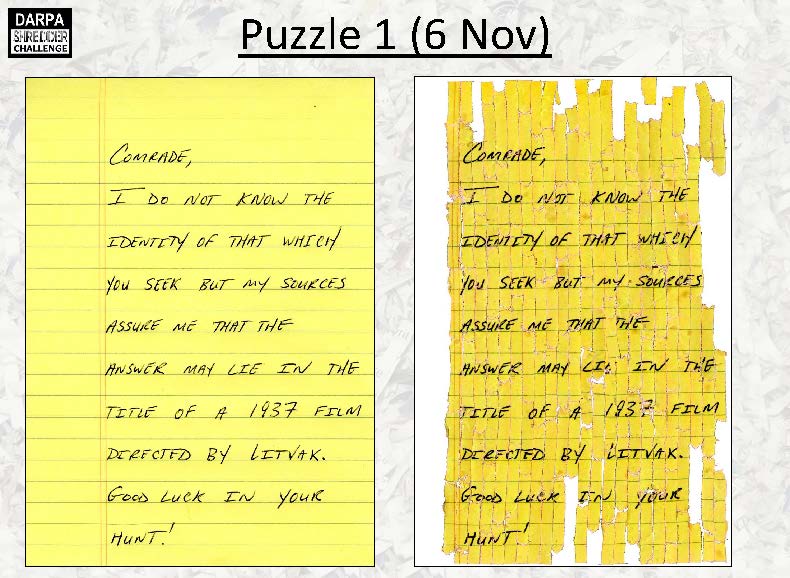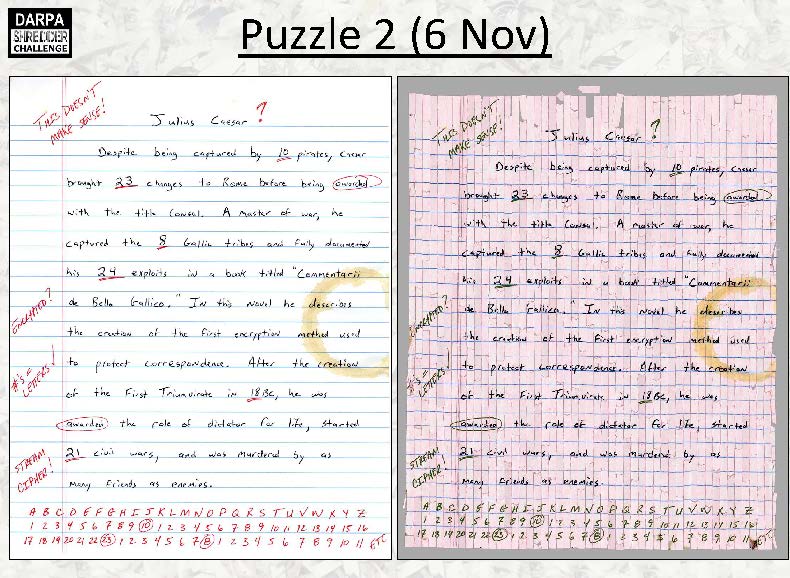In late 2011, Defense Advance Research Projects Agency (DARPA), a research and development agency of the U.S. Department of Defense, invited computer scientists and puzzle enthusiasts alike to take part in an interesting challenge: reconstruct pieces of paper for a grand prize of $50,000. Sounds fairly simple, right? Well, what if those pieces of paper had previously gone through an industrial shredder? Doesn’t seem as easy now, does it?
The goal of the five-puzzle challenge was for participants to develop software that could be used to identify and assess various document reconstruction tactics. The hope was for the U.S. national security community to utilize these new tactics in war zones and use them to identify vulnerabilities to sensitive information within our own country. Participants started their developments on 27 October 2011 and concluded just 33 days later after all five puzzles were successfully solved by a trio of San Franciscan computer programmers.

The winning team, who went by the name, “All Your Shreds Belong to US”, created an algorithm that automatically reconstructed the 10,000 pieces of paper (yes, you read that right: 10,000) based on various physical aspects of the shred, such as shred angle, shred size, and paper marks. Other teams’ strategies ranged from crowdsourced-style methods to relying heavily on manual reconstruction. While the majority of us would rather do anything else than spend approximately 600 hours putting pieces of paper back together, the same cannot be said for hackers and thieves; if it’s going to grant them access to your most sensitive information and confidential data or government defense secrets, then chances are they will rise to the occasion!


There are currently several different secure shredder types ranging from DIN levels P-1 to P-7, with level seven being the most secure particle size. However, there is a lot to be said about modern document destruction if a challenge such as this was so successfully completed, especially within such a small timeframe. If this challenge used level P-7 particles and the winning team not only won the challenge but succeeded two days early, what does that say about the safety of our end-of-life data? Is it safe to assume that there is always the possibility that someone could turn your trash into their own personal treasure? While there currently is no level P-8, we have the next best thing here at SEM (and yes, it is exclusive to us!).

The SEM Model 344 is the next greatest paper shredder as it is offers an even more secure shred size that we like to call P-7+! The Model 344 is the only high security paper shredder on the market that offers a particle size of 0.8mm x 2.5mm, making it 50% smaller than the current National Security Agency (NSA) requirement. This compact, portable, energy saving option is listed on the NSA/CSS Evaluated Products List and has a throughput of 12 reams of paper per hour when feeding five sheets at a time.

When it comes to end-of-life data destruction, it is always best to err on the side of caution. That’s why at SEM, we want you to future proof the destruction of your most sensitive and confidential data with our Model 344. By opting for in-house data destruction methods, you and your company or agency are making the most cost-effective, safe, and secure decision. Still don’t have you fully convinced? Think about it like this: if a group of scientists and puzzle enthusiasts can piece back together your data in their free time, imagine what a full-time hacker could do.
At SEM we have an array of high-quality NSA listed/CUI and unclassified paper shredders to meet any regulation. Any one of our exceptional sales team members are more than happy to help answer any questions you may have and help determine which machine will best meet your destruction needs.

